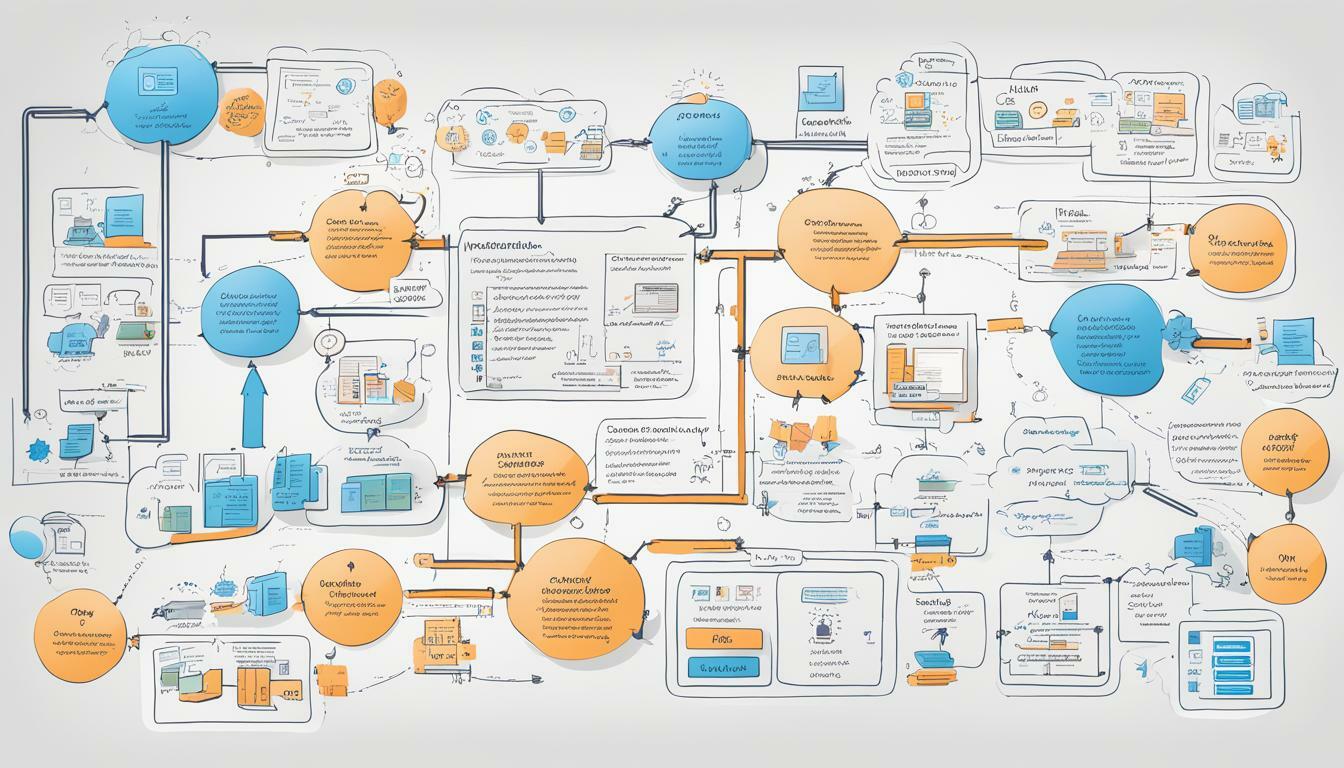
Real-time events are the lifeblood of modern applications, and businesses are leveraging real-time data to stay ahead of the competition. Event-driven architectures are becoming the standard for building resilient, scalable, and efficient applications. Azure Event Grid is a cloud-based messaging service that enables you to build event-driven applications with ease.
With Azure Event Grid, you can automate the process of reacting to events in real-time. It allows you to focus on your business logic, leaving the plumbing to Azure. Azure Event Grid ensures that your application scales seamlessly with event-driven architectures while providing the reliability, security, and cost-effectiveness your business demands.
Key Takeaways:
- Azure Event Grid is a cloud-based messaging service that enables developers to build event-driven applications with ease.
- Real-time events are essential for modern applications, and event-driven architectures are becoming the standard for building resilient, scalable, and efficient applications.
What is Azure Event Grid?
Azure Event Grid is a cloud messaging service offered by Microsoft that enables real-time event processing and routing for event-driven applications. It acts as a mediator between event publishers and subscribers, ensuring that events are delivered quickly and reliably to their intended destinations.
As a fully managed service, Azure Event Grid eliminates the need for developers to manage infrastructure, enabling them to focus on building applications. It also integrates seamlessly with other Azure services, providing a unified experience for building event-driven architectures.
Key features:
- Event routing: Azure Event Grid can route events to multiple subscribers based on event content.
- Scalability: It can handle millions of events per second, making it suitable for high-volume event processing.
- Integration: It integrates with Azure services as well as third-party services, enabling developers to build complex event-driven architectures.
- Serverless: It can be used with serverless architectures, reducing infrastructure management overhead.
Overall, Azure Event Grid is a reliable and efficient cloud messaging service that simplifies event-driven application development and enables real-time event processing at scale.
Building Event-Driven Applications with Azure Event Grid
Azure Event Grid provides an event-driven architecture that enables developers to build serverless applications with real-time efficiency. Event-driven programming is a proactive, scalable approach that responds to stimuli from the environment in real-time. By leveraging Azure Event Grid, developers can build distributed applications that communicate asynchronously and react to events as they occur.
Azure Event Grid integrates seamlessly with serverless architectures, such as Azure Functions and Logic Apps, and enables developers to focus on building modular, decoupled services. By using Azure Event Grid to subscribe to events, developers can build applications that respond to events in near real-time without worrying about managing infrastructure or provisioning resources.
Azure Event Grid also enables developers to build applications that scale automatically. As the load on an application increases, Azure Event Grid automatically provisions more resources to handle the incoming traffic. This means that developers can build applications that perform consistently even under heavy load, without having to worry about infrastructure management.
The benefits of using Azure Event Grid for building event-driven applications are many. Azure Event Grid enables developers to build highly responsive, scalable, and efficient applications that can handle real-time events. This allows organizations to gain deep insights and react quickly to changing business conditions. By leveraging Azure Event Grid, organizations can build applications that are cost-effective, scalable, and resilient, and that can deliver a better user experience to their customers.
Event Publishers and Subscribers in Azure Event Grid
Azure Event Grid makes it easy to build event-driven applications and react in real-time to events that occur within Azure resources or custom applications. To achieve this, Azure Event Grid relies on two fundamental concepts: event publishers and subscribers.
Event Publishers
Event publishers are responsible for generating events in Azure Event Grid. Publishers can be Azure resources such as Blob Storage or Event Hubs, or custom applications that integrate with Azure Event Grid using the REST API or one of the provided SDKs. Each publisher defines the type of events it generates and the schema that describes those events.
By using Azure Event Grid, event publishers can easily notify subscribers of changes to their resources or applications without having to implement complex custom code. Instead, publishers send events to Azure Event Grid, which takes care of the delivery to one or more subscribers in a reliable and scalable way.
Event Subscribers
Event subscribers are the entities that consume events generated by event publishers in Azure Event Grid. Subscribers can be any Azure resource or custom application that can receive HTTP requests, including serverless architectures like Azure Functions or Logic Apps. Subscribers can be added or removed dynamically as the event-driven application evolves, and Azure Event Grid will take care of delivering events to all current subscribers.
Azure Event Grid allows subscribers to filter events based on the attributes defined by the publisher, such as event type or resource path. This enables subscribers to receive only the events they are interested in, reducing network traffic and simplifying development.
Overall, Azure Event Grid provides a flexible and scalable mechanism for building event-driven applications in the cloud. By leveraging the power of event publishers and subscribers, developers can easily build real-time applications that react to changes in Azure resources or custom applications without the need for custom code or complex infrastructure.
Use Cases and Benefits of Azure Event Grid
Azure Event Grid unlocks real-time efficiency and enhances the event-driven architecture approach of building applications. Whether it’s IoT applications, data integration, or real-time analytics, Azure Event Grid is a cost-effective and reliable solution. Let’s explore some of its use cases and benefits.
IoT Applications
In today’s world, there is a need for real-time monitoring and analysis of data generated from IoT devices. Azure Event Grid can be used to efficiently process and analyze the massive amount of data streaming from IoT devices. It can trigger a reactive function to carry out specific actions, such as sending notifications or alerts to end-users.
Data Integration
Azure Event Grid simplifies and streamlines the process of data integration by providing a centralized platform to manage events across various applications. It can efficiently route events between different systems, providing a seamless flow of data across the entire application ecosystem. With Azure Event Grid, businesses can make informed decisions in real-time based on the data received.
Real-time Analytics
Azure Event Grid provides the ability to perform real-time analytics on events generated by applications. It enables developers to use the stream of events to detect anomalies, visualize data patterns and generate insights in real-time. By using Azure Event Grid with services such as Azure Functions and Azure Stream Analytics, businesses can implement real-time decision-making strategies.
In conclusion, Azure Event Grid is a powerful tool for building event-driven applications that can help businesses unlock real-time efficiency. It provides a scalable and reliable platform to manage events and integrate them seamlessly across various systems. By using Azure Event Grid, businesses can make informed decisions based on real-time data, enhance productivity, and deliver an enhanced user experience.
Conclusion
In conclusion, Azure Event Grid is an excellent cloud messaging service that enables event-driven applications to operate with real-time efficiency. By leveraging event-driven architecture, Azure Event Grid offers scalability, flexibility, and cost-effectiveness for building serverless applications. Furthermore, event publishers and subscribers can easily manage events, enabling real-time data integration applications and real-time analytics.
Using Azure Event Grid offers many benefits, including reduced operational costs and increased reliability. As a result, it is an excellent choice for IoT applications, data integration, and real-time analytics. The possibilities of event-driven architectures using Azure Event Grid are limitless, and it is up to you to explore them fully.
In summary, Azure Event Grid plays a vital role in unlocking real-time efficiency for event-driven applications. By using Azure Event Grid, you can enhance your applications’ scalability, cost-efficiency, and reliability, and take full advantage of the benefits offered by event-driven architectures.
FAQ
Q: What is Azure Event Grid?
A: Azure Event Grid is a cloud messaging service that enables event routing in event-driven applications. It allows you to publish and subscribe to events from various sources and provides a reliable and scalable way to handle real-time events.
Q: How can Azure Event Grid be used to build event-driven applications?
A: Azure Event Grid is a powerful tool for building event-driven applications. It integrates seamlessly with serverless architectures and provides a scalable and efficient way to handle events. By using Azure Event Grid, you can easily connect different components of your application and enable real-time communication between them.
Q: What are the roles of event publishers and subscribers in Azure Event Grid?
A: In Azure Event Grid, event publishers generate events and event subscribers consume those events. Publishers can be any service or application that can emit events, while subscribers can be functions, webhooks, or any other endpoint capable of receiving events. Azure Event Grid provides a flexible and scalable way to manage event publishers and subscribers.
Q: What are some use cases and benefits of using Azure Event Grid?
A: Azure Event Grid can be used in various scenarios, such as IoT applications, data integration, and real-time analytics. It enables you to process events in real-time, react to changes instantly, and build scalable and reliable applications. Azure Event Grid is a cost-effective solution that helps unlock real-time efficiency and enhance event-driven architectures.







